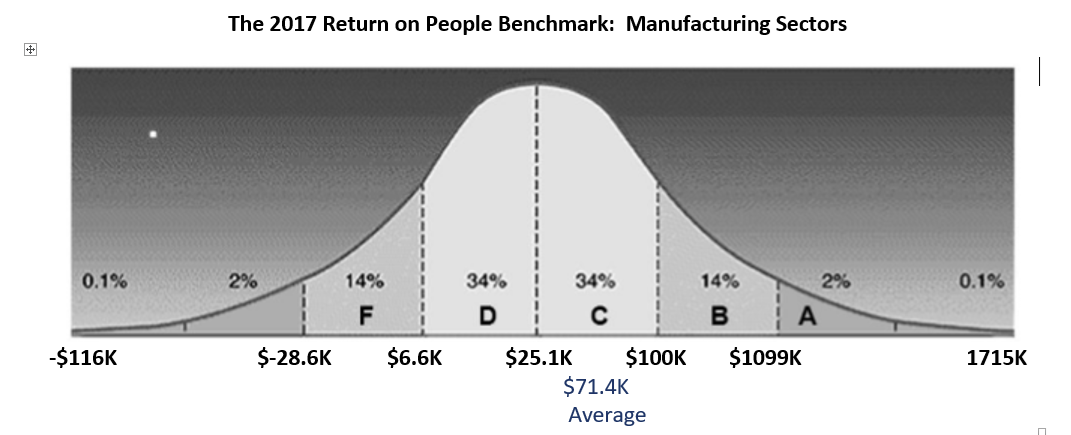Founder, Profit and the 5-Step P.R.O.F.I+T Plan, Boston Conference Workshop Leader, Register for Anne’s workshop!
Return on People™ Benchmark is a very useful KPI for evaluating people-centric profitability, by providing a comparative measure of how well you convert the talent, engagement, and loyalty of your employees and customers into bottom line value. It’s a powerful tool for setting the bar higher than you ever thought you could by creating a plan to achieve it, because once you see what others have already achieved, you’ll be motivated to follow, achieve, and surpass their performance.
Here’s how to calculate and compare your results against 163 of the biggest manufacturers in the world.
Fast Facts:
- Over half the manufacturers in this year’s Benchmark earn less than $25K of profit per employee.
- The average manufacturer in the Benchmark earns almost 3x more than what “A” grade manufacturers earn 15x as much as the average firm.
Your grade on the benchmark speaks to strengths or challenges in efficiency, effectiveness, productivity, leadership, market relevance, and execution of strategy.

Are you average? Below average? Above average? It’s time to find out how you rank:

The Return on People™ Benchmark is based on bell-curving the profit-per-employee of the Fortune 500, but don’t let that concern you if you’re a small or mid-size company. The data below reflects only manufacturing companies across 30 sectors with further details in this downloadable infographic, so that you can benchmark your specific industry. Just let me know if you’d like further details for your industry, I’m happy to provide them.
The 2017 Return on People Benchmark: Manufacturing Sectors

Is your firm an Unsung Hero?
Bigger is not always better! Regardless of your revenues, please share your results with me, especially if you’ve earned a B or an A – we will feature high-performing AME members an upcoming edition of Target magazine, along with a more in-depth look at the metric and how to improve your results.
Why it matters
You routinely measure ROA, ROE, ROI, ROC, and a host of other ROX’s. But what we rarely ever see is ROP: Return on People. And its is a key differentiator that drives competitive advantage.
People – whether your employees or your customers are your greatest asset… your greatest expense… your worst headache when you don’t have the right ones… your greatest source of growth, prosperity and possibilities… and the only asset in your business that votes with their feet every day, deciding whether to re-engage the next day.
Over the 10+ years that I’ve been producing the Benchmark and speaking with thousands of business leaders, only a handful have ever used this metric. A slightly larger number measure Revenue per Employee, but we all know that revenue can be a highly dangerous metric. In fact, more than 1 in 10 of the manufacturers in the Benchmark – some of the largest manufacturers in the world – are losing money, putting jobs, their customers, and their own survival at risk.
The Challenge: Raise Your Grade
We consistently hear criticism of North American productivity, of a disengaged workforce, of too many unemployed and too many jobs going wanting due to skills mismatch. All of which are true to some extent. The manufacturers in the Return on People Benchmark paint a different picture.
- In some cases, it’s a picture of extraordinary successes that can only be achieved through fully engaged and productive people creating value for customers.
- Its also a picture of extraordinary failure – of companies who produce and sell immense amounts of products but have nothing to show for their efforts at the end of the day.
Surprisingly, there are leaders and laggards within almost every industry. Some are A players… and some are an F. If the A players can figure out how to leverage people in a positive way for profit, you too can build a proactive, people-centric Profit Plan that delivers results.
If every company simply set their sights one grade higher and executed a proactive, people-centric profit plan to achieve that goal, we would be a prosperous and thriving economy indeed. What steps will you take to earn a higher grade in the coming fiscal year?


